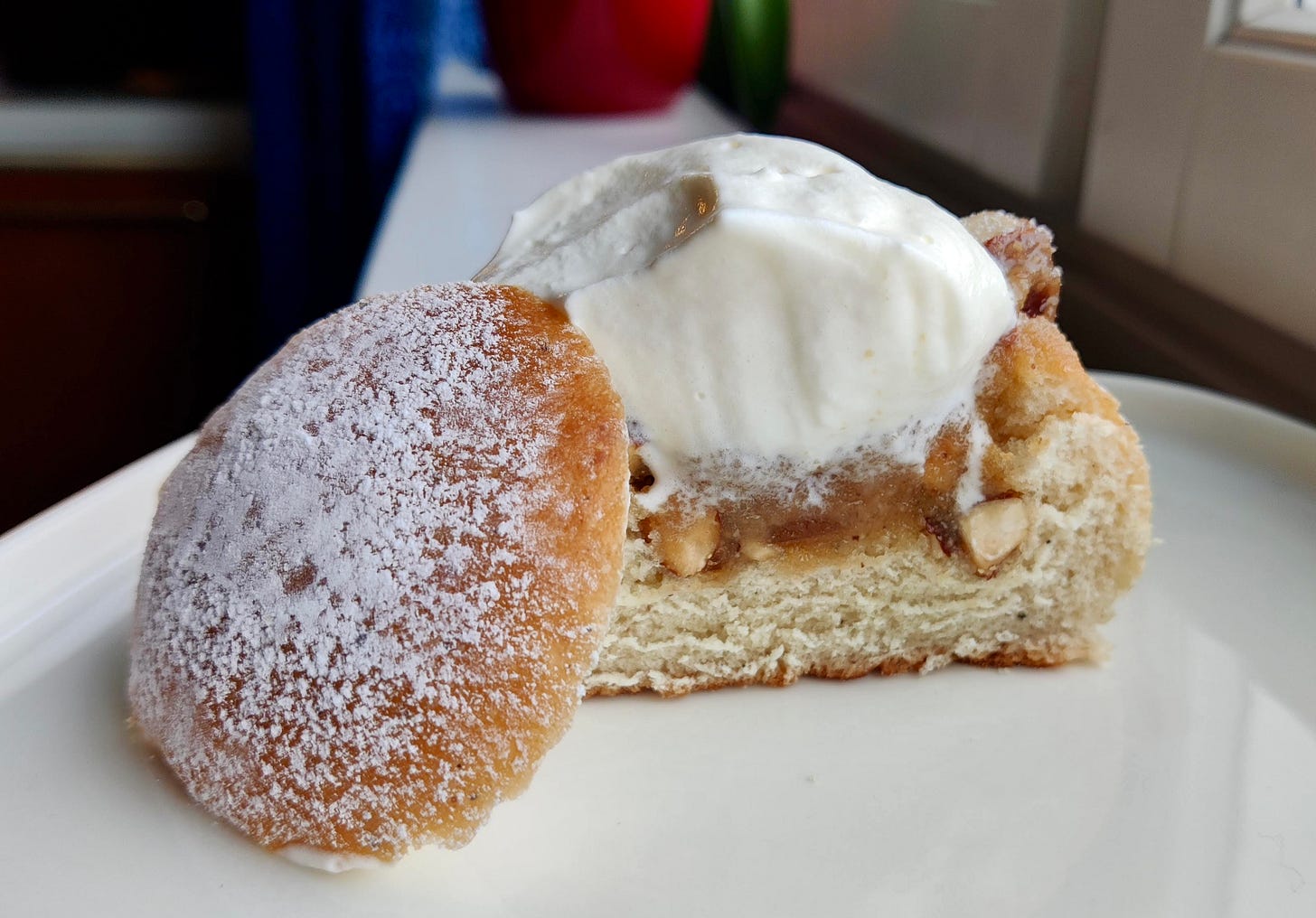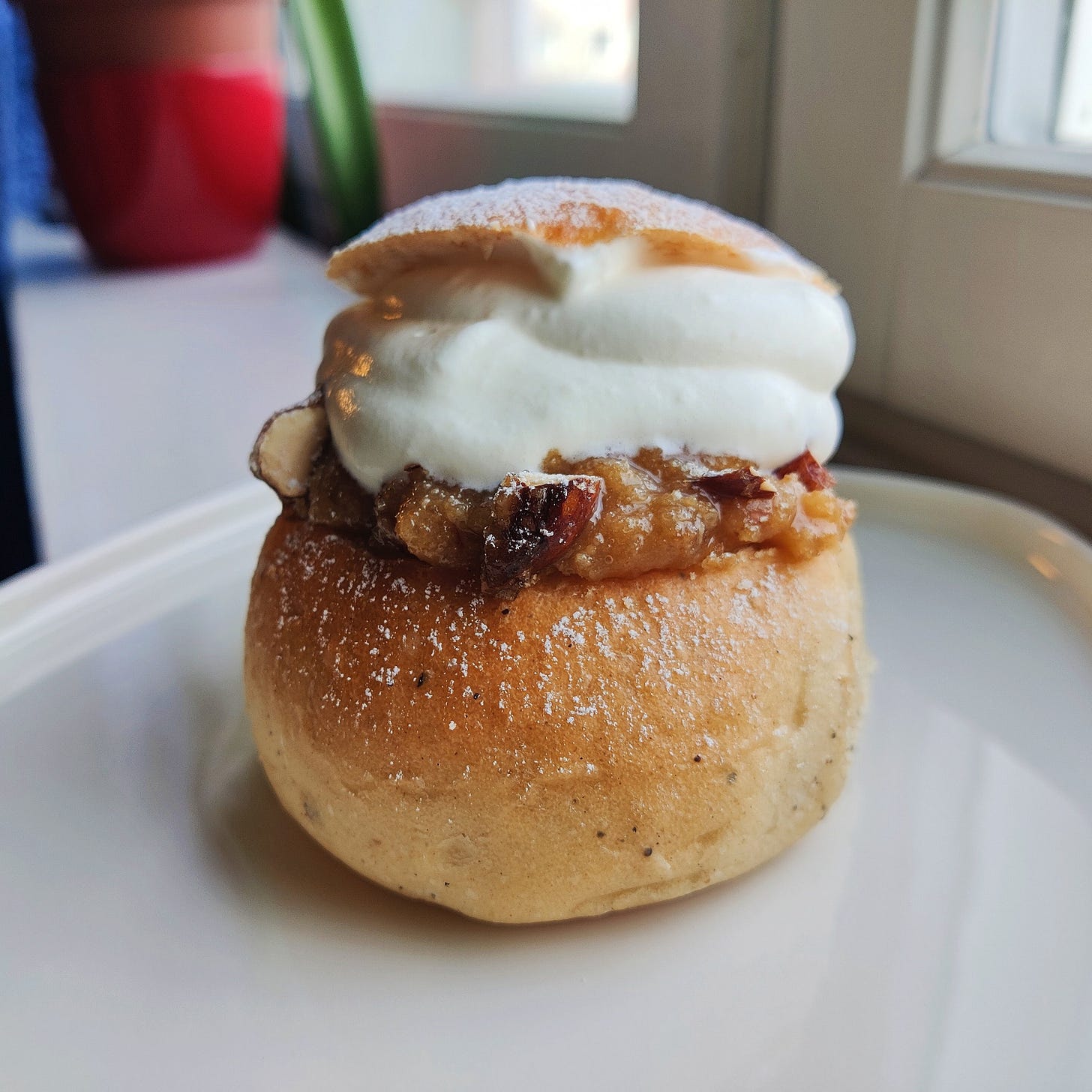Old, Intelligent, and Full of Bun
And assorted things about Stephen Hawking, a dreadful Swedish chef, and the arbitrariness of recipes.
Hello and holy potatoes it’s basically March and I still haven’t:
Started the novel
Gone for that dental appointment
Learnt how to spell rthym
I really need to chill out on my resolutions every January.
Well, at least the fun and games at The Recovering Line Cook feel good a few months into 2025. Highlights for me have been this look at things I love about Nordic food, and this very long-winded look at Finnish buns and life as an immigrant.
To those of you who keep reading, thank you so much. And special thanks to those who have upgraded to paid subscribers, let me tell you how much that means to me. You keep this machine running!
This week I’m sharing, among other things, reflections on my mother’s feelings toward Stephen Hawking, and a bun that knocks the socks off even the best Shrove Tuesday pancake.
Cheers,
Wil
How do you spell arsehole in Swedish?
My earliest memories of science and experimentation and the wonders of the universe come courtesy of my mother.
She didn’t go to university in her late teens. Instead, she worked on her undergraduate degree after having 4 kids and a career as cabin crew at British Airways.
This is why, alongside her copy of Prue Leith’s Confident Cooking, my mother also had trays of maggots in the kitchen for an experiment she was tasked with one semester.
Something to do with whether they like cold or dry conditions, she tells me.
Yes, I think a lot of my interest in the natural world comes from her.
But, if anything, she is a woman of multitudes, my dear mother. And for all the faith in hard science she has, she did once have a passion for resident Joe Rogan Show pseudo-archaeologist Graham Hancock and his books about Mayans using laptop computers and the world ending in 2012.
This was a date we looked toward with some concern if I remember our post-millennial life together correctly.
This ability to question accepted notions of things also sums up her feelings toward Britain’s archetypical genius: Stephen Hawking. I distinctly remember her saying about him:
“Oh, the man’s probably making it all up and no one’s clever enough to disagree with him.”
I often think about my mother’s feelings toward Professor Hawking when I watch cookery shows or recipe clips on Instagram these days.
As a professional cook, I feel privileged to know a thing or two about cooking. I went to a very traditional culinary school, learnt a lot about technique, and plied my trade in some really good restaurants.
One of the ancillary benefits of this is being able to call out kitchen bullshitters when they’re talking kitchen bullshit.
In various shows/online videos I’ve seen lately this has included:
Someone telling viewers that salt must ONLY be put in the end when cooking scrambled eggs or they’ll be watery
Not true
Someone putting a pound of butter under the skin of a chicken to keep the meat moist
It just won’t, only final temperature (and brining to an extent) impacts on how juicy meat will be
And someone saying salt will kill yeast so definitely don’t add it at the same time when making bread
At worst salt slows the yeast, it won’t kill it
I understand the temptation to do this. Like any great skill, the ability to cook is a special thing. People who can’t do it look up to those who they think have this “privileged” expert knowledge.
Now, of course, anyone can be an expert “chef”, it just takes a few hundred thousand followers on Instagram and you might even end up on national TV to show off how great you are.
But, as I’ve spent time writing about before, this doesn’t mean you're a reliable source of information.
Whether in badly researched books or TV shows, bullshit is a problem because we need to be able to trust people who are afforded these platforms.
I mean, you’re never going to do yourself much harm shoving 5 pounds of butter up a chicken’s backside before roasting it, but if some poor fucker does so expecting the result to be perfectly juicy meat, despite the fact he goes on to cook it half-way to hell, then he’s going to be pretty upset when it comes out drier than a camel’s armpit.
I admit to being sensitive to this because I have some past trauma when it comes to shitty recipes from someone I was supposed to trust.
In one of my memoir entries of life as a new restaurant cook, I mentioned a colleague called Konrad.
I spoke in that chapter about how much the head chef/owners loved young, fresh-faced Konrad. They loved him so much, in fact, that they hired a weird British 30-year-old immigrant with barely any experience so Konrad had someone to practice his latent management skills on.
Hi, weird British immigrant was me, nice to meet you.
The thing about Konrad I didn’t mention before is that he also fancied himself as some kind of René Redzepi/Heston Blumenthal culinary experimentalist.
If I were tasked with making even basic things such as crème anglaise or chocolate mousse, things the head chef had given me freedom to make as I knew how, Konrad would strongly “suggest” I use only his recipes.
Unfortunately, I’d soon find out, his recipes demanded arcane twists on traditional technique, seemingly arbitrary temperature requirements, even demands on what kind of underwear I was allowed to wear when making them.
OK, the underwear one is an exaggeration but, as my “line manager” and new to chef life, I did as told.
Whether it was his brown butter hollandaise or a bavarois flavoured with sea buckthorn, his recipes were as reliable as my ability to write amusing similes.
Yes, Konrad was a bit of an arsehole really.
What to do with a recipe…
Considering most of them were inaccurate, Konrad took unnecessary recipe details to a grotesque extreme, of course.
But how often are the minute details we’re given in recipes ever all that important?
Of course, for some technical things the traditional list of amounts and measurements are non-negotiable. Things like baking, I suppose. But, as someone who loves cookbooks, I often find myself drawn to the larger ideas of a recipe than the (often arbitrary) minutiae of how many red peppers I’m supposed to use, cloves of garlic, or twists of the pepper mill.
This is why I so admire
’s book First, Catch, called by his publisher a “cookbook without recipes”. Eschewing such things as ingredient lists and quantities, it guides the reader through a multi-course feast giving beautiful insight into technique, theory and history. I’d love to see more “cookbooks” in such a style. Books that, while giving something honest and real of the writer and doing justice to his food, also give the reader space to, where appropriate, assume a little more agency.That’s the way I like to read cookbooks at least. Getting inspiration from the big ideas, the story, the history of a dish. The small details, even from a best-selling author, are often just personal preference anyway.
It’s not like we’re ever arguing over black hole radiation with Stephen Hawking, after all.
A Recipe for Nordic Lent Buns, aka Semla (Swedish) and Laskiaispulla (Finnish)
Having said that, here comes a traditionally written recipe with a full ingredients list and measurements. But, that said, I do think this recipe is a good example of the dance that can be enjoyed between important specifics and spaces you can freestyle a little.
These buns are traditionally eaten in the run up to lent across the Nordic countries. I use a very similar recipe for the dough as is traditional. The kind of enriched, yeast-leavened type you’d find in Magnus Nilsson’s book on Nordic food, for example.
The buns are flavoured lightly with cardamom (like most buns are around here, even cinnamon buns have a base of cardamom), and, once the tops are sliced off, filled with, depending on which side of the Gulf of Bothnia you live on, Jam (Finland) or almond paste (Sweden). They are then topped with whipped cream before adding the sliced off part again like a little doughy hat.
Charming things.
I am resolutely team almond, though my wife is typically Finnish in her preference for jam.
With its caramelised almonds and the use of toasted almond flour, I am particularly proud of the recipe for the paste here. But even this part of the recipe is open to your tweaking. You might prefer to use a little less granulated sugar in the paste, you might want to use more or less of the caramelised almonds. You could even choose not to caramelise them at all and simply roast them. All very fair alterations that, while keeping what I love most about this recipe (big chunks of almond in the paste), might make it more to your taste.
To make it even simpler you could forget the almond element entirely and throw a dollop of good jam in there instead like a good little Finn.
This, however, is how I make them.



